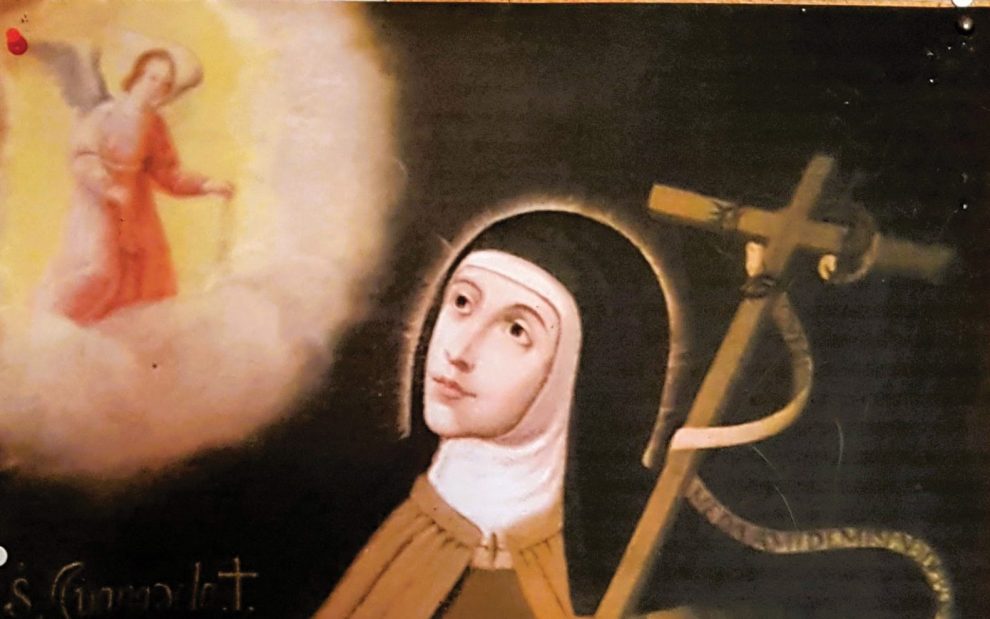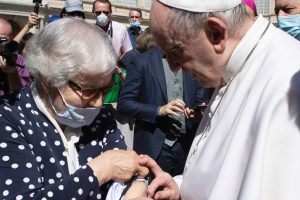When Juana de la Cruz Vasquez Gutiérrez was only 4 years old, she was injured in a fall from a horse. As she lay on the ground, she had a vision in which Mary and her guardian angel appeared to her. Miraculously, Juana was healed. She would grow up to be a great mystic, reform a group of Franciscan women at the Shrine of Santa María de la Cruz near Toledo, and serve as the pastor of the parish near her monastery. Eventually she would be called Santa Juana and be counted among the great mystics of the Golden Age of Spanish mysticism. But her devotion to Mary began with the accident, vision, and healing when she was a child.
Juana was born on May 3, 1481, to peasant farmers in the small town of Azaña, Spain. Appropriately, the name Juana means “grace of God.” When Juana was 15, her father began to pressure her to marry against her will, so she disguised herself as a boy and fled her home in the middle of the night to join the sisters at the Beaterio in Cubas, a town near Toledo. When she arrived, she had another mystical experience: a vision of Mary, who welcomed her and encouraged her Franciscan vocation.
Juana’s mystical reputation led to her becoming abbess in 1509, when she was 28. A year later, Cardinal Francisco Cisneros made her pastor of the parish church in Cubas. While some objected to a woman serving as pastor, Pope Julius II confirmed her title and role later that year. As a pastor, she was able to administer the church’s goods, shepherd the people, and preach for parishioners’ edification. Although she hired priests to do sacramental ministry for the parish, she was clearly in charge.
Juana’s preaching attracted bishops and other prelates, theologians, Franciscan men and women, and even the Spanish royal family. Her 72 sermons, the Conhorte (or “Consolation”), span a whole liturgical year.
Though Juana was popularly declared a saint following her death in 1534, she was not formally canonized, possibly because some church leaders were uncomfortable with some of the homoerotic imagery in her sermons. Finally, however, several centuries later, the Dicastery for the Causes of Saints is studying her life and sermons as part of the process leading up to a formal canonization. On October 12, 2015, Pope Francis approved Juana as a Venerable Servant of God.
Learned Franciscans had already reviewed and studied Juana’s sermons, the Conhorte, in the 16th century. They hoped she would be made a doctor of the church, especially given her defense of the mother of Jesus. Her Marian spirituality, like that of Blessed John Duns Scotus, influenced the Franciscans in Spain for well over a century after her death. The focus of her sermons is on God’s mercy toward sinners and the intercession of Santa María, the Mother of Mercy, on behalf of sinners.
The Conhorte contains seven sermons on Santa María, which address the eight main topics of systematic Mariology: her role as Mother of God; her immaculate conception; her virginal integrity; her ongoing sanctification in the events of her life and the life of Jesus; her being full of grace; her dormition, resurrection, and assumption into heaven; her role as a model and intercessor for Jesus’ disciples; and her cooperation with Christ in the work of redemption.
The first mention of the Virgin Mary in Juana’s Conhorte is in the very first sermon, which is dedicated to the incarnation. According to this sermon, the mystery of the incarnation was revealed to our first parents and to the prophets, who implored, “Come, Lord, do not delay!” The angels in heaven also implored the Lord to hurry and become incarnate among them, so that the thrones abandoned by Lucifer and his companions could be filled with human beings.
After various human generations, Juana preached, the Lord revealed that a virgin had been predestined for such a task. Jesus then scolded the angels, telling them he would not become incarnate to help fill empty thrones; rather, incarnation is the fruit of his love of humankind. Here Juana shares the traditional Franciscan understanding that Mary’s role in the incarnation was predestined.
Juana affirms Mary’s natural and spiritual bond with the incarnate Son of God, a bond that is manifest in her immaculate conception—the work of the Father of Lights, his only begotten Son, and the Holy Spirit Comforter who “created her the purest and cleanest and most polished that ever was and will be.”
All of Juana’s references to Mary reflect Mary’s special relationship with God as her father, her son, and her spouse. The greatest of these relationships is the one she has with her son, who in his role as the “great priest of mercy” offers the sacrifice of his body and blood on behalf of humanity. Juana’s sermons remind us that Jesus received his body and blood solely from his mother and that this body and blood are offered in the world’s most common and ordinary elements—bread and wine. According to the Conhorte sermons, Jesus shares his great priesthood only with his mother. While ordained priests can only offer Jesus in the bread and wine, Mary offered her flesh and blood to her son—flesh and blood that are the great signs of God’s mercy.
Mary, who is referred to as “black and beautiful” in Juana’s sermons, because she is one of us, is exalted and taken to heaven to be with the Holy Trinity, who, Juana says, offers to give her whatever she desires. As Mary’s ears are always inclined to the Earth, toward sinners, she claims she desires only sinners, referring to them as her friends, her siblings. She identifies with humanity, as does her son. Juana teaches that Mary intercedes on our behalf and that Jesus responds by proclaiming her a sacerdote grande (great priest). In Sermon V, which focuses on Mary’s purification, Jesus names his mother the great priest “who offers the true sacrifice that is I (Jesus), the living and powerful God.”
With this honor, the mother of Jesus goes to both holy and sinful people, offering everyone the opportunity to receive her son in communion. Unlike ordained priests, Santa María offers him as the flesh of her flesh and blood of her blood as a precious and sweet-tasting host. Or perhaps she offers him as the baby Jesus to be played with or as a loving friend, fiancé, or spouse. Jesus’ mother can bring him in communion to everyone in ways that they are able to appreciate and understand.
It is clear from Juana’s sermons why Cardinal Cisneros made her pastor. Her pastoral heart is revealed in her descriptions of Jesus’ mother. She understands that ordained priests are limited in how they can reach people and bring Jesus through communion, while the royal priesthood of the baptized represented by the mother of our Lord can take Jesus everywhere, to everyone, in a variety of ways. Juana helps us imagine Mary as the great priest who models priesthood to all baptized Christians.
This article also appears in the January 2024 issue of U.S. Catholic (Vol. 89, No. 1, pages 19-20). Click here to subscribe to the magazine.
Image: Courtesy of Gilberto Cavazos-González













Add comment